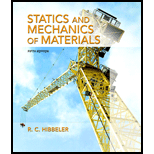
Concept explainers
What is the weight in newtons of an object that has a mass of (a) 8 kg, (b) 0.04 kg, (c) 760 Mg?
(a)
Convert the weight in newton of an object that has a mass in
Answer to Problem 1P
The weight in newton of an object that has a mass of
Explanation of Solution
The mass of the object is
Write the conversion for the quantity.
Write the conversion formula.
Convert the weight in newton from
Thus, the weight in newtons of an object is
(b)
Convert the weight in newton of an object that has a mass in
Answer to Problem 1P
The weight in newton of an object that has a mass of
Explanation of Solution
The mass of the object is
Write the conversion for the quantity.
Write the conversion formula.
Convert the weight in newton from
Thus, the weight in newtons of an object is
(c)
Convert the weight in newton of an object that has a mass in
Answer to Problem 1P
The weight in newtons of an object that has a mass of
Explanation of Solution
The mass of the object is
Write the conversion for the quantity.
Write the conversion formula.
Convert the weight in newton from
Thus, the weight in newtons of an object is
Want to see more full solutions like this?
Chapter 1 Solutions
Statics and Mechanics of Materials Plus Mastering Engineering with Pearson eText - Access Card Package (5th Edition)
Additional Engineering Textbook Solutions
Automotive Technology: Principles, Diagnosis, And Service (6th Edition) (halderman Automotive Series)
Electric Circuits. (11th Edition)
Fluid Mechanics: Fundamentals and Applications
Concepts Of Programming Languages
Thermodynamics: An Engineering Approach
Problem Solving with C++ (10th Edition)
- The coefficient of friction between the part and the tool in cold working tends to be: lower higher no different relative to its value in hot workingarrow_forwardThe force F={25i−45j+15k}F={25i−45j+15k} lblb acts at the end A of the pipe assembly shown in (Figure 1). Determine the magnitude of the component F1 which acts along the member AB. Determine the magnitude of the component F2 which acts perpendicular to the AB.arrow_forwardHi can you please help me with the attached question?arrow_forward
- Please can you help me with the attached question?arrow_forwardPlease can you help me with the attached question?arrow_forward4. The rod ABCD is made of an aluminum for which E = 70 GPa. For the loading shown, determine the deflection of (a) point B, (b) point D. 1.75 m Area = 800 mm² 100 kN B 1.25 m с Area = 500 mm² 75 kN 1.5 m D 50 kNarrow_forward
 Refrigeration and Air Conditioning Technology (Mi...Mechanical EngineeringISBN:9781305578296Author:John Tomczyk, Eugene Silberstein, Bill Whitman, Bill JohnsonPublisher:Cengage Learning
Refrigeration and Air Conditioning Technology (Mi...Mechanical EngineeringISBN:9781305578296Author:John Tomczyk, Eugene Silberstein, Bill Whitman, Bill JohnsonPublisher:Cengage Learning
